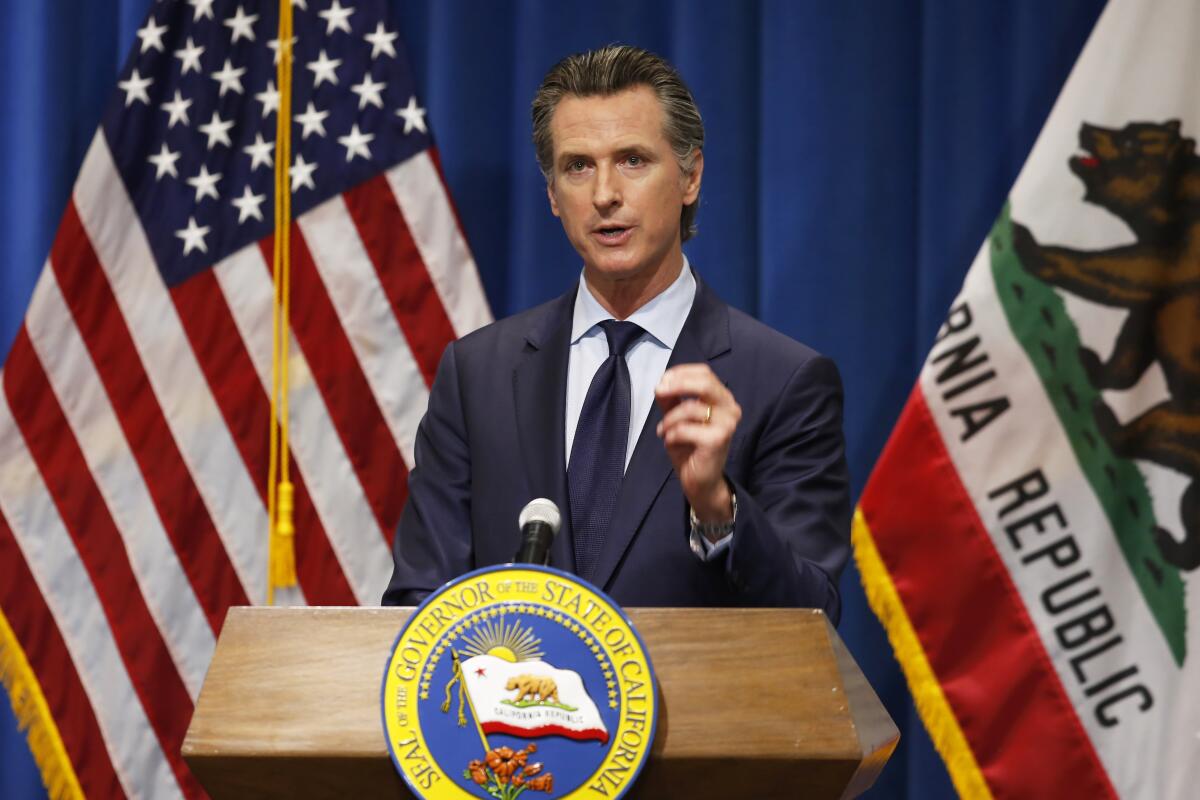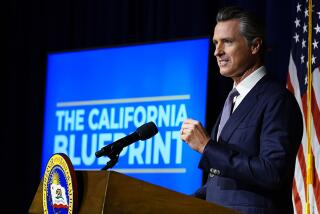Newsom’s budget targets reopening, reviving public schools and universities

- Share via
In a turnaround from recent dire predictions, Gov. Gavin Newsom’s proposed budget boosts next year’s funding for K-12 school districts and includes emergency grants to reopen campuses as soon as possible — part of a sweeping effort to address learning loss and social stresses in children.
Higher education also benefited from increased support, and the governor rejected any increase in tuition.
The total dollars — about $90 billion for kindergarten through community college — is almost certain to leave education officials wanting more, but also provides much of what they’d asked for. Newsom’s proposal comes in addition to $6.7 billion in recently approved federal education funding for California.
“We are proposing to the Legislature a record investment in our public schools,” said Newsom, “to deal with the disproportionate impacts of this pandemic on ... our low-income communities.”
For most of the state’s students, campuses have been essentially closed since March, with instruction moving online. Students from low-income families, especially Black and Latino students, have been slower to receive the computers and broadband they need to keep up with schoolwork. Many also have difficult learning environments at home — including higher rates of COVID-19, increased economic instability and added family responsibilities that include supervising younger siblings and jobs.
“Distance learning has not met everybody’s needs equally,” Newsom said. “And that’s exactly what this is intended to do.”
The budget generally received measured praise.
“The governor’s budget is a big step toward meeting the needs of diverse school districts throughout the state,” said Troy Flint, a spokesman for the California School Boards Assn. “But it’s not comprehensive and does not provide the level of transformative money needed to mitigate the effects of learning loss long-term.”
“This is going to be a generational effort,” he added.
Newsom has earmarked $4.6 billion to address learning loss, which school districts are expected to use for such purposes as an extended academic year and summer school. He allocated $400 million for school-based mental health services. And the governor wants $2 billion for reopening grants that would be available to every school district and campus-based charter school. Grant applications can be turned in as soon as the beginning of next month.
By early February — health conditions permitting — the governor hopes to see campuses open for students in kindergarten through Grade 2, with older elementary grades soon to follow and secondary students coming after.
The money available for reopening would range from $337.50 to $800 per student, with larger amounts going to districts that apply more quickly and to districts with high numbers of low-income families or other targeted groups of students with special needs.
One concern, raised in a letter to Newsom by superintendents from seven large urban school districts, is whether the grants would be distributed equitably. Many districts might be unable to open under the governor’s timetable because of local health conditions.
In his remarks and in documents released with the budget, Newsom sought to ease those concerns. The proposal would reserve funding for all districts that can submit a plan for future reopening “once rates drop and in compliance with state and local health requirements,” according to a state outline.
If a school system takes the money, it would have to provide, as soon as health conditions allow, “optional in-person instruction” to students with disabilities, youths in foster care, children who are part of homeless households, students without adequate internet access and all students in transitional kindergarten through sixth grade — at the least.
At the college level, Newsom proposed a 3% increase in base funding for the University of California and Cal State, which would help the two public university systems recover somewhat from staggering financial losses and added expenses triggered by the COVID-19 pandemic.
Newsom said added funding came with the “expectation” of no increase in tuition or fees — which is something that senior leaders at undergraduate campuses have been considering, calling such hikes difficult to avoid.
While education officials praised Newsom for prioritizing education, he was able to do so because of higher tax revenues than recently projected. In contrast, early in the pandemic-induced recession, the budget outlook appeared to be catastrophic, likely to force districts to slash programs and carry out sweeping layoffs.
The process of decoding the complex budget proposal has now begun, and already there are concerns. One issue raised by school district officials is whether the governor used money for his COVID-response package that would have gone to education anyway. Those worries were echoed Friday by union leaders.
“The budget rightly sets aside money for COVID-19 testing and vaccination, but that funding should come from public health funds” and not from dollars needed “for the regular operation of classrooms,” said Cecily Myart-Cruz, president of United Teachers Los Angeles.
Separately, some district leaders don’t like that the grants seem to require a sign-off from unions representing teachers as well as those representing most non-teaching employees. Not surprisingly, union leaders favor such a provision.
The governor treaded carefully on the issue Friday, saying that moving forward for the benefit of students would require participation from all parties, but that he would oppose those who refused to collaborate on reopening campuses.
More to Read
Sign up for Essential California
The most important California stories and recommendations in your inbox every morning.
You may occasionally receive promotional content from the Los Angeles Times.













